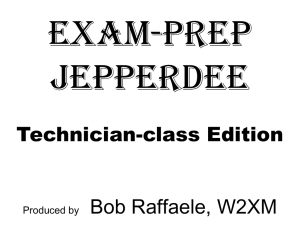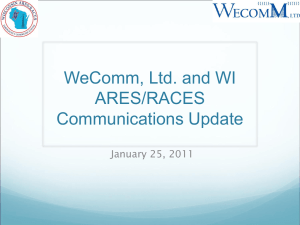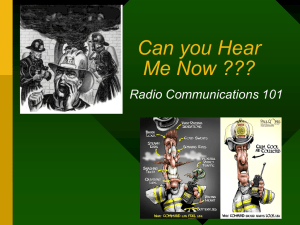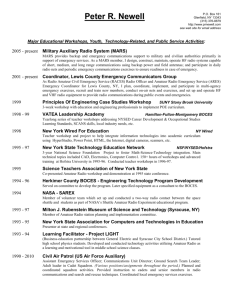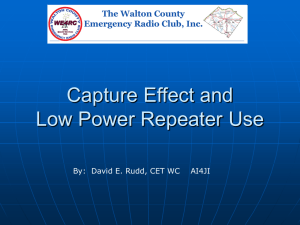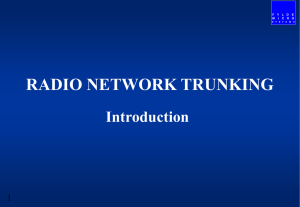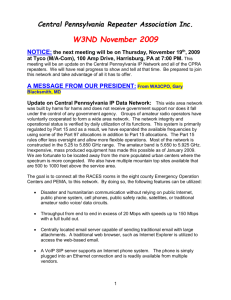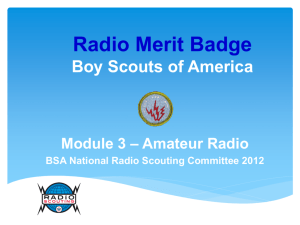The ARRL Amateur Radio Emergency Communications Course
advertisement
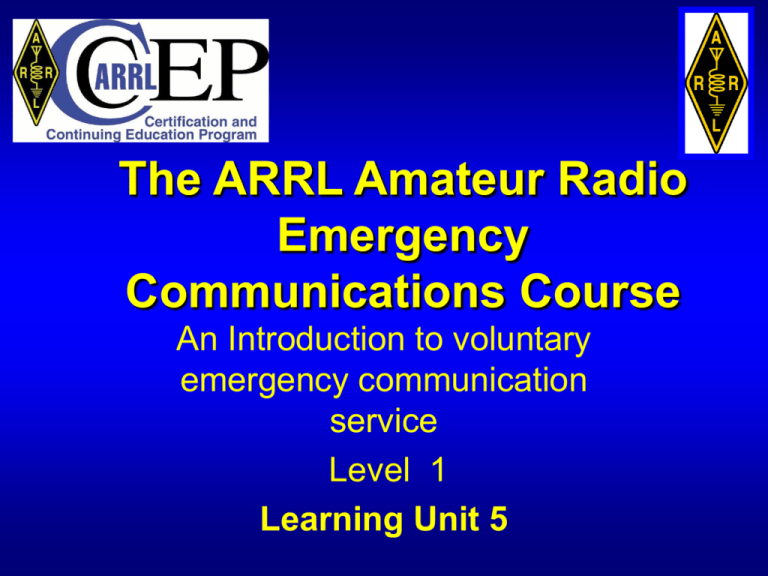
The ARRL Amateur Radio Emergency Communications Course An Introduction to voluntary emergency communication service Level 1 Learning Unit 5 Served Agency Communication Systems Learning Unit 5 Objectives: Emcomm volunteers may be asked to use the agency's own communication systems, in addition to Amateur Radio. This unit attempts to familiarize you with some of the systems you are likely to encounter. Served Agency Communication Systems Learning Unit 5 Student preparation required: Become familiar with the "Continuous Tone Coded Squelch System" (CTCSS), also known by various common trademarks, including Private Line (PL)*, and Channel Guard (CG)*. * Private Line is a trademark of Motorola, Inc. - Channel Guard is a trademark of General Electric/Ericcson. Going Beyond Amateur Radio Most served agencies will have their own communication systems and equipment, ranging from modest to complex. In our ever-broadening role as emergency communicators, we may be asked to operate some of this equipment. If this occurs, you must become familiar with its operation. Your emcomm group should work with the served agency well in advance to determine whether the agency will need you to use its equipment, and under what conditions. Many of these radio systems are quite different from ham radio, and special training may be required. In addition to different equipment, on-air procedures will definitely be different. Training and drills may be necessary to make Amateur Radio emcomm operators proficient. State and Local Government Radio Systems: These systems might include those licensed to police, fire, sheriffs, highway, and other state, county, or city departments. If you are asked to use any of these systems, be sure to learn their standard operating procedures, and "phonetic alphabet" system if one is used. Some departments may use familiar ITU Phonetics, some will use military systems, and still others will make them up as they go along. In addition, a few departments still use a "10 code" or something similar, but most are moving away from special codes in favor of plain language. Be careful not to lapse into a ham radio operating style. Casual conversations are prohibited by FCC rules and are usually not permitted by the agency. All transmissions must be directly related to the agency's mission. State and Local Government Radio Systems: Many police agencies are licensed for operation on 155.475 MHz, sometimes known as the "National Police Frequency." The FCC has set aside this channel to allow intercommunication between any police agency, regardless of state or jurisdiction. Unfortunately, many departments are not aware of its intended use and treat it as their own private "car to car" channel. Many will not know they have a common channel since they use "channel designators" rather than frequencies. In addition, CTCSS was not supposed to be used on this channel to ensure inter-agency compatibility, but many departments use it anyway. This may become important if different police agencies must intercommunicate with each other in an emergency. If one or more use CTCSS, they will need to disable it by placing their radios in the "monitor" mode, if possible. Medical Radio Systems: In order to standardize emergency medical radio systems across the country, the FCC assigned a number of dedicated frequencies. In theory, every ambulance in the country should be equipped to use all these frequencies. In practice, true compatibility is usually limited to a specific region. The older system, often called "MedStar," used 10 simplex VHF frequencies with a dial-type pulsed-tone encoder to signal specific hospitals. This system is still in use in some rural areas, but is quickly being replaced by more modern systems. The newer Emergency Medical Radio Service uses 10 UHF duplex frequency pairs; one assigned to the hospital, the other to the ambulance, and 7 VHF simplex channels. The UHF channels are known as "Med 1" to "Med 10." In some cases, the hospital's radio is located on a nearby mountain or tall tower in order to achieve the required coverage, and connected to the emergency department by a radio or telephone link. American Red Cross: ARC has a nationally licensed frequency (47.42MHz) that can be used by all ARC chapters, and is intended primarily for disaster or emergency operations. This common channel ensures that ARC units responding from various chapters will be able to communicate with each other. Some chapters also use 47.50MHz. In addition, certain chapters may rent space on commercial systems or license their own VHF or UHF systems for dayto-day operations. Types of Served-Agency Radio Systems In larger jurisdictions, each agency will probably have its own radio system, completely independent of all other radio users in the same area. This is especially true of large city and state police and fire radio systems. Many agencies have more than one channel, assigned to different purposes. For instance, a fire department might have a "dispatch" channel, and one or more "fireground" channels. This allows local operations at a fire scene to be kept separate from on-going dispatch operations. A police department may have a separate channel for detectives, or one for each precinct. These systems may be on repeaters or use simplex frequencies. The FCC allocates specific radio frequencies to different types of agencies, and some for multi-agency use. For instance, a frequency designated for use by police agencies may only be used for police business. The same is true of fire radio allocations. "Local Government" allocations may be used for any legitimate local government function. Types of Served-Agency Radio Systems In addition to "simple" systems where each user group has its own frequency, there are three different types of systems that allow multiple user groups to share resources. These are known as "community repeaters," "trunked repeater systems," and "shared simplex systems." Community Repeater Systems: Unlike Amateur Radio repeater systems, a "community" or "shared" repeater uses a different CTCSS tone for each of several user groups. For instance, a city might have one repeater shared by the water, public works, and sanitation departments, licensed as a single "local government" radio system. Since each department uses a different CTCSS tone, they will not normally hear each other's conversations, but only one department can use the system at any given moment. Some very small rural towns may even combine fire and police department operations on the same system, either on a repeater or simplex frequency. When using any shared frequency -- repeater or simplex -- it is important to press the "monitor" button for a moment before transmitting. This disables the CTCSS decoder, temporarily allowing you to hear any transmissions being made on the frequency. Some mobile radios automatically switch to "monitor" mode when the mic is removed from its hang-up clip. In this way you can be certain that no one else is using the channel before making your call. Community Repeater Systems: In an emergency situation, these shared channel systems can quickly become overloaded. A common practice is to end all non-essential communications or perhaps move them to an Amateur system instead. Trunked Systems: Trunked systems provide an efficient means for several "low volume" users to share a single radio system. They use several co-located repeaters tied together, using computer control to automatically switch a call to an available repeater. When one radio in a group is switched to a new frequency, all the others in the group automatically follow. This is accomplished by having a computer controller move the conversation from frequency to frequency in accordance with a pre-established algorithm. The number of available frequencies in the system depends on its design, and the number of different user groups. Channel switching and assignment data is transmitted on a dedicated channel. Unlike a shared single-frequency repeater system using multiple CTCSS tones, a trunked system will provide almost instant ondemand clear channels in normal usage. Amateur Radio does not currently use this type of system. In emergency situations, however, most trunked systems suffer from a lack of reserve capacity. To keep designs cost effective, there are always many more user groups than available channels. The number of available channels is designed to handle the normal day-to-day communications load. When an emergency occurs, these systems can be quickly overloaded with calls, and finding a clear channel can be difficult or impossible. Trunked Systems: One "solution" to this problem is to assign certain users or user groups "priority" over others. If all the available channels are occupied, a higher priority user will bump the lowest priority user off the system and take over the channel. Priority status can either be full time or turned on in an emergency depending on the system's design. APCO Project 25 Radio Systems: In the 1990s, a new public safety radio system was developed to deal with problems of interoperability between agencies with different radios. The Association of Public Safety Communications Officers (APCO) created the Project 25 working group, which created what has become known as the Project 25 (P25) Standard. P25 radios are extremely flexible, with both forward and backward compatibility. This means that they can be configured to operate in both analog and digital voice modes, and as part of trunked and conventional radio systems. P25 radio systems are becoming more common across the country as federal funds become available. The advantages of P25 systems are obvious. Radios from several manufacturers can be programmed to communicate with each other seamlessly, as can radios from different agencies and jurisdictions. Digital modes offer excellent audio quality, and optional encrypted modes offer message and data security. APCO Project 25 Radio Systems: The disadvantages are less obvious. While P25 digital systems work well in urban environments, they are not as effective in rural or mountainous areas. While analog signals can fade in and out, digital signals, are either there or they're not, just like a digital cellular telephone signal. Telephone Systems Telephone systems in use by public service agencies vary greatly. The served agency should be able to provide training in its use. Most telephone systems come with user manuals, and if possible a copy of one should be included in your group's training materials. Most business telephone systems allow the following basic functions, with which you should be familiar: • Answering incoming calls • Placing outside calls • Placing and answering intercom calls • Making "speed dial" calls • Overhead paging • Placing calls on hold, and then retrieving them. • Transferring calls to another extension. • Transferring calls to voice mail, if available • Retrieving calls from a voice mail box Telephone Systems There may be other, more advanced functions available, but in most cases you will not need to learn them for temporary operations. However, it is always a good idea to keep the user's manual close at hand. Satellite Telephones Satellite phones and data terminals are becoming more common among served agencies as the cost of ownership and airtime decreases. As of this writing, satellite telephone/data service is offered by a number of companies, including Inmarsat, Iridium, Thuraya, and Globalstar. Some of the services cover much of the earth's surface, others only certain regions. Of these, Iridium's 66 satellite low earth orbit (LEO) constellation has the most coverage with 100%, followed by Inmarsat at 98% of the earth's total surface, and Globalstar with 80% land-area coverage. Thuraya, based in the United Arab Emirates, covers most of Europe, the Middle East, and North Africa. Some phones or terminals require that an antenna be pointed directly at the satellite, others do not, but all require line-of-sight to the satellite. Some are handheld, others are contained in briefcases and must be set up before operating. In addition to voice communication, some companies offer paging, fax and data transmission, although at slower speeds than a typical landbased dial-up connection. A few phones also integrate a terrestrial cellular phone in the same unit. Satellite Telephones Calls are typically expensive when compared to cellular telephone calls. All calls made through these systems are considered to be "international" calls, and each company has one or more "country codes." If you need to use one of these phones, keep conversations short and to the point. While most of the phones are fairly simple to use, due to the wide variety of phones and services it is essential that users be fully trained in their use. Satellite Data Systems Satellite systems in use by public service agencies also vary greatly. Some are used for two-way data and voice communication, others for one-way reception of voice, data, or video. One popular system is the NOAA Emergency Management Weather Information System (EMWINS) system, which allows emergency management officials to obtain up-tothe-second weather maps and information. This system recently underwent a complete revision. If you were trained on the older system, you may need to be retrained. As with many other served agency systems, the agency will have to provide training in their use if they want you to be able to operate this equipment. Other Agency-Owned Equipment In addition to radio and telephone systems, you may need to use fax machines, copiers, computers, and similar devices. Since many of us use these items every day at work, learning their operation should not be a problem in most cases. However, some copiers and computer programs are quite complicated and may require instruction in their use. Computer software used in public safety applications is usually specially written for the purpose and may require extensive training in the rare situation where you will be required to use the system. Review While some served agency systems may be familiar to Amateur Radio operators, others are not. Both equipment and procedures may vary greatly. If a served agency expects its emcomm volunteers to be able to operate any of its systems, specific training should be provided in advance. Student Activity A. What do Sections 97.403 and 97.405 of the FCC Rules and Regulations (www.arrl.org/FandES/field/regulations/rules-regs.html) Part 97 state about Amateur communications during emergencies? B. Which courses offered by IMSA (www.imsasafety.org/certify.htm) pertain to radio operations? To what extent do these courses pertain to emcomm operations? Question 1 When emcomm team members are called upon to operate on Public Safety Radio Systems, which of the following may they NOT do? A. B. C. D. Use special "10 codes". Use the served agency's standard operating procedure. Use the phonetic alphabet employed by the served agency. Engage in casual conversations. Answer 1 When emcomm team members are called upon to operate on Public Safety Radio Systems, which of the following may they NOT do? D. Engage in casual conversations. Question 2 Which of the following is another trademarked version of Continuous Tone Coded Squelch System (CTCSS)? A. B. C. D. Private Guard. Private Channel. Line Guard. Private Line. Answer 2 Which of the following is another trademarked version of Continuous Tone Coded Squelch System (CTCSS)? D. Private Line. Question 3 Which of the following best describes the newer Emergency Medical Radio Services? A. B. C. D. Ten UHF duplex frequencies and seven VHF simplex channels. Ten simplex VHF frequencies with pulsed tone encoders for each hospital. Seven UHF duplex frequencies and ten VHF simplex channels. The MedStar system with channels Med 1 through Med 10. Answer 3 Which of the following best describes the newer Emergency Medical Radio Services? A. Ten UHF duplex frequencies and seven VHF simplex channels. Question 4 Which one of the following statements is true about trunked systems? A. B. C. D. Trunked systems are able to operate without the use of computer controllers. The number of frequencies on a trunked system is always a multiple of 10. Amateur radio does not currently use this type of system. Most trunked systems have ample reserve capacity Answer 4 Which one of the following statements is true about trunked systems? C. Amateur radio does not currently use this type of system. Question 5 When emcomm teams work with a served agency, a number of assumptions are made. Which of the following assumptions are true? A. Amateur radio operators can operate any communication equipment they encounter. B. There are NO significant differences between amateur radio operating procedures and the procedures used by the served agencies. C. Served agencies must provide training if amateur operators are to be used effectively. D. All phonetic alphabets are essentially the same and are thus interchangeable. Answer 5 When emcomm teams work with a served agency, a number of assumptions are made. Which of the following assumptions are true? C. Served agencies must provide training if amateur operators are to be used effectively.
